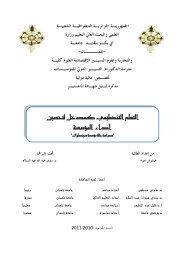Critical Thinking Skills - Developing Effective Analysis and Argument(2)
Critical Thinking Skills - Developing Effective Analysis and Argument(2)
Critical Thinking Skills - Developing Effective Analysis and Argument(2)
Create successful ePaper yourself
Turn your PDF publications into a flip-book with our unique Google optimized e-Paper software.
people are referring to when they mention<br />
these, <strong>and</strong> so you can apply them yourself as<br />
-<br />
relevant;<br />
build<br />
confidence in your own ability to apply<br />
critical thinking techniques;<br />
examine closely the opinions, views <strong>and</strong><br />
arguments presented by other people;<br />
challenge other people's views from an<br />
informed perspective when this is<br />
appropriate.<br />
For students<br />
Students will find the book particularly useful in<br />
developing the ability to:<br />
recognise the arguments of specialist authors;<br />
locate arguments in key texts with greater<br />
speed;<br />
engage with the arguments used by both<br />
experts <strong>and</strong> their peers;<br />
produce better critical analytical writing of<br />
their own for marked assignments;<br />
recognise the difference between critical<br />
analysis <strong>and</strong> other kinds of writing, such as<br />
description.<br />
Activities in the book<br />
<strong>Critical</strong> thinking is an activity. It isn't sufficient<br />
to read about it: it has to be practised. The book<br />
offers activities to apply the concepts it<br />
introduces <strong>and</strong> to practise new skills. It may be<br />
that, after completing one or two of the<br />
activities that accompany a new concept, you<br />
find that aspect very easy. If so, move on to the<br />
next aspect. However, many people find some or<br />
all aspects of critical thinking to be difficult at<br />
first. If this is true of you, be reassured that this<br />
way of thinking becomes easier with practice.<br />
The answers pages do not simply provide a<br />
correct answer: they also explain the reasons<br />
behind the answers so as to develop further the<br />
concept that has been practised. Reading<br />
through these should help you to clarify your<br />
underst<strong>and</strong>ing about that aspect of critical<br />
thinking.<br />
A wide range of topics is used as examples <strong>and</strong><br />
as practice material. You do not need any<br />
background knowledge of the subjects covered<br />
in these. It is possible to do all the activities no<br />
matter what your subject discipline or area of<br />
interest. The activities require you only to apply<br />
critical thinking to the material provided.<br />
Passages used in the book<br />
All of the passages in the book have been<br />
specially designed to illustrate the key points of<br />
each chapter <strong>and</strong> to provide appropriate practice<br />
material. They draw on a range of different<br />
academic disciplines but are written in such a<br />
way that you do not need to be an expert in the<br />
subject to underst<strong>and</strong> the material.<br />
These passages are short to enable you to<br />
identify the key points more easily, <strong>and</strong> to<br />
provide many practice examples. In real life, it is<br />
likely that you will need to identify arguments<br />
<strong>and</strong> evaluate reasoning in much longer texts.<br />
Some chapters provide more extended passages<br />
to enable you to work on several aspects of<br />
critical thinking simultaneously by working with<br />
longer texts.<br />
None of the passages in this book is reproduced<br />
from any other text. However, some draw on<br />
the writing of others for background<br />
information. Where this is the case, details of<br />
the original source are given at the end of the<br />
chapter to enable you to follow up subjects that<br />
interest you.<br />
Terminology: author <strong>and</strong><br />
audience<br />
The different aspects of critical thinking covered<br />
in this book can be applied to material in varied<br />
media, whether written, audio or televisual.<br />
However, in order to simplify the text, the terms<br />
'author' <strong>and</strong> 'audience' are used throughout,<br />
irrespective of the type of media.<br />
Author<br />
This refers to the person who creates the<br />
message, whether this is written, spoken or<br />
delivered through another medium. It doesn't<br />
necessarily mean the 'author' of a book.<br />
Introduction<br />
ix



